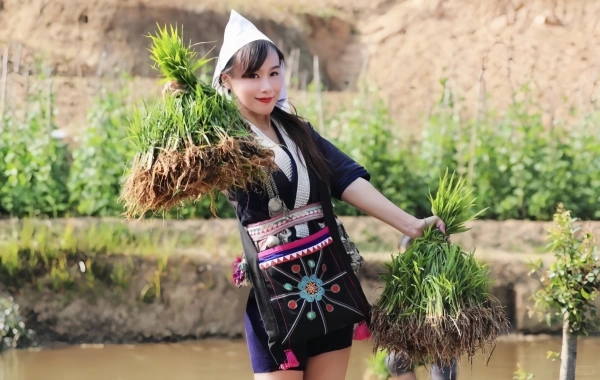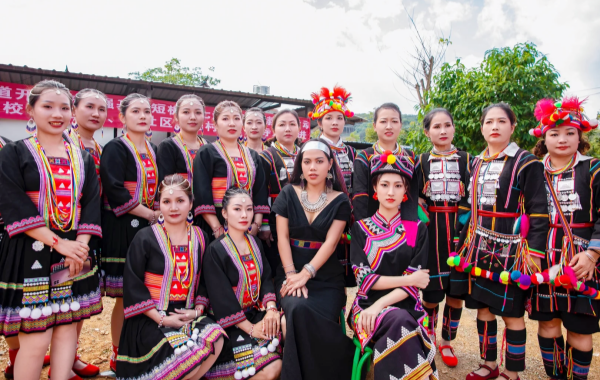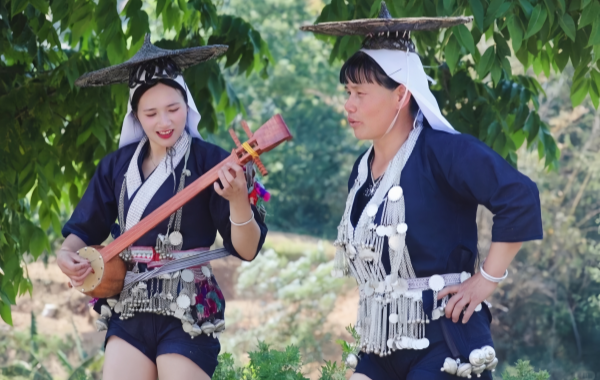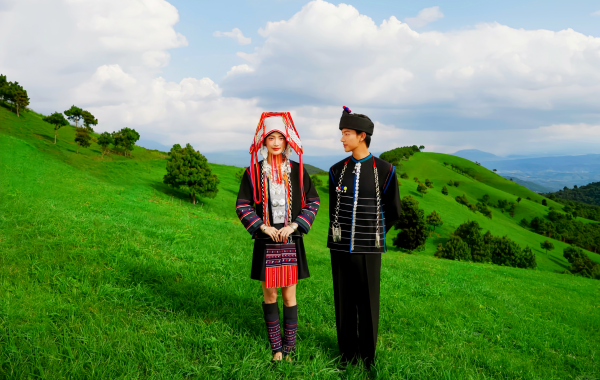Hani
Introduction

The Hani ethnic is a culturally vibrant ethnic group in China. Renowned for their magnificent terraced fields, unique traditional costumes, and rich folk culture, the Hani people have a long - standing history and have formed a close - knit community with a strong sense of ethnic identity. Their cultural heritage has added a unique charm to the diverse tapestry of Chinese culture, attracting the attention of scholars and tourists from around the world.
 History
History
Origin
The origins of the Hani people can be traced back to ancient times. Some theories suggest that they are descendants of the ancient Qiang people. Over centuries, through a series of migrations and interactions with neighboring ethnic groups, they gradually settled in the mountainous regions of southern Yunnan and developed their own distinct cultural identity.
Development
Historically, the Hani people were mainly engaged in agriculture. They made the most of the mountainous terrain by constructing elaborate terraced fields. These terraces not only allowed them to cultivate rice, corn, and other crops but also became a symbol of their ingenuity and hard work. In addition to agriculture, they were involved in forestry, hunting, and fishing, which provided additional food sources and materials for daily life. Hani society was organized in a village - centered manner, with a well - defined social structure and traditional governance systems that maintained order and harmony within the community.
Modern Times
In modern times, the Hani people have experienced significant social and economic changes. With the improvement of transportation and communication infrastructure, they have had increased contact with the outside world. The government has implemented various policies to promote the development of ethnic minority areas, leading to improvements in living standards, education, and healthcare for the Hani people. At the same time, efforts have been made to preserve and promote Hani culture, including language, traditional crafts, and folk performances.
 Population
Population
Quantity
As of the latest census data, the Hani population in China is approximately 1.73 million, making them one of the medium - sized ethnic minorities in the country.
Distribution
The Hani people are mainly concentrated in the southern part of Yunnan Province. Honghe Hani and Yi Autonomous Prefecture is the heartland of the Hani ethnic group, where a large proportion of the Hani population resides. Pu'er City and Xishuangbanna Dai Autonomous Prefecture also have sizable Hani communities. Their distribution is closely related to the geographical environment, with villages often located on hillsides and in valleys with access to water and fertile land for terraced farming.
 Economy
Economy
Traditionally, the Hani economy was based on agriculture, with terraced farming being the cornerstone. The terraced fields were a remarkable achievement, allowing the Hani people to grow a variety of crops. They also raised livestock such as pigs, cattle, and water buffalo. Forestry played an important role, providing timber for construction and fuel, as well as non - timber forest products like mushrooms, herbs, and wild fruits. Hunting and fishing were supplementary economic activities, especially in areas with abundant wildlife and water resources.
In modern times, the Hani economy has diversified. Many Hani people are now involved in industries such as tourism, handicrafts, and the service sector. The unique Hani culture, including the terraced fields, traditional villages, and folk performances, has become a major tourist attraction, generating income and creating employment opportunities. At the same time, modern agricultural techniques are being adopted to improve crop yields and develop high - value agricultural products, such as specialty teas and organic vegetables, further boosting the local economy.
 Culture
Culture
Language and Script
The Hani language belongs to the Tibetan - Burmese group within the Sino - Tibetan language family. It has several dialects. In the past, the Hani people did not have a widely - used written script. However, in recent years, the government has promoted the use of the Latin - based Hani script to help preserve and transmit Hani culture. This has facilitated the documentation of Hani folklore, history, and traditional knowledge.
Religious Beliefs
Polytheism is the main religious belief of the Hani people. They worship a wide range of gods, including nature gods such as the mountain god, river god, and sun god, as well as ancestor gods. These gods are believed to have control over various aspects of life, such as agriculture, health, and family well - being. Animism is also deeply ingrained in Hani religious practices, with a belief that all things in nature have spirits. Ancestor worship is an important part of Hani religious life, with families often holding ceremonies to honor their ancestors and seek their blessings. Some Hani people also practice Buddhism and Christianity, which have had some influence on their religious rituals and moral concepts.
 Clothing
Clothing
Traditional Hani clothing is colorful and reflects the ethnic group's unique aesthetic. Women's clothing typically features black as the base color, with bright - colored embroidery and decorations. The embroidery patterns often depict natural elements such as flowers, birds, and butterflies, symbolizing good luck and happiness. Women also wear elaborate headpieces, necklaces, and earrings, which add to their overall appearance. Men's clothing is relatively simple, usually consisting of a short - sleeved or long - sleeved shirt and trousers, often paired with a belt and a hat. In some regions, men may also wear a traditional cloak made of animal skins or wool.
Literature
Hani literature has a rich oral tradition, including folk songs, legends, and proverbs. Folk songs are an important part of Hani culture, covering a wide range of topics such as love, labor, and history. These songs are passed down from generation to generation through oral transmission and are often sung during festivals, weddings, and other social gatherings. Legends and proverbs reflect the Hani people's beliefs, values, and life experiences, providing insights into their cultural heritage and worldview. Some Hani legends tell the story of their ancestors' migration and the creation of the terraced fields, while proverbs offer practical advice on life and social behavior.
Transportation
In the past, due to the mountainous terrain, the Hani people mainly relied on walking and pack animals such as horses and mules for transportation within and between villages. They built wooden bridges across rivers and streams and stone paths on the mountainsides to facilitate movement. In modern times, with the development of infrastructure, roads have been constructed in many Hani - inhabited areas, and motorcycles, cars, and buses have become common means of transportation. However, traditional wooden bridges and stone paths are still preserved as cultural landscapes and tourist attractions, showcasing the Hani people's ingenuity in adapting to the natural environment.
 Science
Science
Medicine
Traditional Hani medicine is based on a combination of herbal remedies and spiritual practices. Hani healers, known as "moyi," have extensive knowledge of local herbs and their medicinal properties. They use these herbs to treat various diseases, often accompanied by rituals and prayers to invoke the help of gods and ancestors. Traditional Hani medicine emphasizes the balance of the body's energy and the harmony between humans and nature. In recent years, there has been growing interest in integrating traditional Hani medicine with modern healthcare systems to provide more comprehensive medical services for the Hani people.
Calendar
The Hani people have their own traditional calendar, which is closely related to agricultural seasons and natural phenomena. The calendar is used to guide farming activities, such as when to plant and harvest crops. It also marks important cultural events and festivals, helping the Hani people to maintain their cultural traditions and sense of time. The traditional calendar is based on the lunar cycle and is often supplemented by observations of the sun, moon, and stars. For example, the Hani New Year is celebrated according to the traditional calendar, marking the beginning of a new agricultural cycle.
 Art
Art
 Music
Music
Hani music is characterized by its lively rhythms and unique vocal styles. Folk songs are an important form of Hani music, with different types of songs for various occasions, such as love songs, work songs, and festival songs. Traditional Hani musical instruments include the "hege" (a bamboo mouth organ), the "buluo" (a stringed instrument), and various types of drums. Hani music often expresses the people's emotions, such as joy, sadness, and longing, and reflects their life experiences and cultural values. During festivals and celebrations, Hani people gather together to sing and dance, creating a lively and festive atmosphere.
Dance
Hani dance is energetic and expressive, with movements that are closely related to daily life and work. Traditional Hani dances include the "wooden drum dance," the "farming dance," and the "harvest dance." These dances are often performed during festivals, weddings, and other social gatherings, bringing people together in a joyful and harmonious way. Dancers wear colorful costumes and perform with enthusiasm, showcasing the Hani people's artistic talents and cultural vitality. The wooden drum dance, in particular, is a significant cultural symbol, with the wooden drum being considered a sacred object that connects the Hani people with their ancestors and gods.
Architecture
Hani architecture is known for its unique style and practical design, well - adapted to the mountainous environment. The most characteristic Hani building is the "mushroom house." These houses are usually made of wood and thatch, with a conical roof that resembles a mushroom. The mushroom house is designed to withstand strong winds and heavy rain, and its shape also helps to collect rainwater. The houses are often built on hillsides, with the ground floor used for storing livestock and firewood, and the upper floors for living quarters. Hani villages are usually built in a clustered pattern, with houses arranged around a central square or a communal area, creating a sense of community and unity.
Landscape
The Hani - inhabited areas are characterized by beautiful natural landscapes, including mountains, rivers, forests, and terraced fields. The terraced fields built by the Hani people on the hillsides are not only a marvel of agricultural engineering but also a beautiful scenic spot, especially during the planting and harvest seasons. When the fields are filled with green rice plants in spring and summer, or golden rice grains in autumn, they present a breathtaking view. The clear rivers and streams winding through the villages add to the charm of the landscape, providing a source of inspiration for Hani artists and poets. The forests in the Hani - inhabited areas are rich in biodiversity, serving as important ecological barriers and providing resources for the Hani people's daily life.
Arts and Crafts
Hani arts and crafts are renowned for their fine workmanship and unique designs. Traditional Hani crafts include embroidery, bamboo - weaving, wood - carving, and silver - making. Hani embroidery is famous for its delicate patterns and bright colors, often used to decorate clothing, bedding, and household items. Bamboo - weaving is used to make various daily necessities such as baskets, mats, and fans. Wood - carving is used to decorate buildings, furniture, and religious objects, with motifs often depicting animals, plants, and mythical creatures. Silver - making produces exquisite jewelry and ornaments, which are often worn by Hani women during festivals and special occasions. These crafts are not only important cultural symbols but also provide economic income for the Hani artisans.
 Custom
Custom
Etiquette
Hani etiquette is based on respect, hospitality, and politeness. When visiting a Hani home, guests are usually greeted warmly and offered tea or wine. It is customary to accept these offerings as a sign of respect for the host. The Hani people also place great importance on greetings and polite language. When meeting elders or guests, young people should show proper respect, such as bowing slightly or using formal titles. During meals, there are certain rules of etiquette, such as waiting for the elders to start eating first and not making loud noises while eating. It is also considered impolite to point at others with chopsticks or leave food on the plate.
 Marriage Customs
Marriage Customs
Hani marriage customs are rich in tradition and ritual. Marriages are often arranged by the families of the bride and groom, but the consent of the couple is also important. The wedding ceremony is a grand event that involves several steps, including engagement, dowry delivery, and the wedding feast. During the engagement ceremony, the groom's family presents gifts to the bride's family as a sign of their sincerity. The dowry delivery is an important part of the marriage process, with the groom's family providing various items such as livestock, furniture, and jewelry. The wedding feast is held in the bride's village, and it is a time for family and friends to celebrate the union of the couple. There are various traditional rituals during the ceremony, such as the bride and groom drinking cross - cupped wine, which symbolizes their mutual love and commitment.
Festivals
The Hani people celebrate many important festivals throughout the year. The Hani New Year, also known as "Kuzhazha," is one of the most significant festivals. It is celebrated in autumn after the harvest, and it marks the beginning of a new agricultural cycle. During the festival, people clean their houses, prepare special foods, and participate in various cultural activities such as singing, dancing, and wooden drum performances. Another important festival is the "Long Street Banquet," which is held during the Spring Festival (Chinese New Year). On this day, people set up long tables along the streets and share food with neighbors and friends, symbolizing unity and harmony. The Dragon Boat Festival, the Mid - Autumn Festival, and other traditional Chinese festivals are also celebrated by the Hani people, but with some unique Hani customs and traditions.
Diet
Hani cuisine is characterized by its fresh ingredients and unique flavors. Staple foods include rice, corn, and sweet potatoes. Common dishes include spicy fish, smoked meat, and pickled vegetables. The Hani people have a tradition of making spicy and sour foods, which help to preserve food and add flavor. They also like to drink homemade rice wine and tea, which are often served during festivals and social gatherings. One of the famous Hani dishes is "bamboo rice," which is made by putting rice and other ingredients into a bamboo tube and cooking it over an open fire. The bamboo gives the rice a unique aroma and flavor.
Funeral Customs
Hani funeral customs are based on respect for the deceased and the belief in an afterlife. When a person dies, the family will hold a series of funeral rituals, including washing the body, dressing it in new clothes, and placing it in a coffin. Shamans or elders will perform prayers and rituals to guide the soul of the deceased to the afterlife. Family and friends will gather to pay their respects and offer condolences, and a funeral feast is held to honor the memory of the deceased. The mourning period varies depending on the relationship with the deceased, and relatives and friends will continue to offer support to the bereaved family during this time. In some regions, the Hani people also have the custom of building a memorial tower for the deceased, which serves as a place for family members to pay their respects in the future.
What Our Clients Say?
Based on 10,000+ traveler reviews











